Build
a worm farm
Ruud Kleinpaste visits
a commercial worm farm to gather tips on how to set up and maintain
your own 'farm'.
Power Organics is the
largest worm farm in the southern hemisphere. 60 tonnes of earthworms
operate here — that's 240 million creatures. Each year they
chomp through 10,000 tonnes of organic green waste, and in the process
they make the most wonderful fertiliser.
Worm cast is biologically
active and free of artificial substances. Cobi Thompson of Power
Organics thinks it's the way of the future — a clean, green
way of improving soil and caring for the environment.
How, then, do you keep
60 tonnes of earthworms happy?
"They like a mixture
of greenfeed, grasses, paper pulp, and a good mixture of moisture,"
says Cobi.
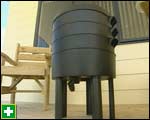 "They don't like it too hot. They probably deal with cold a
little bit more than what we think. Moisture is probably the most
important thing for them. If they haven't got moisture, they're
just not happy."
"They don't like it too hot. They probably deal with cold a
little bit more than what we think. Moisture is probably the most
important thing for them. If they haven't got moisture, they're
just not happy."
Small-scale worm farms
are available at plant shops and some building suppliers. They follow
similar principles to those used by Power Organics: you put the
organic waste on top, add worms and soil to the second level, and
the worm cast will drop to be collected on the third.
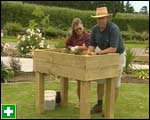 But if you're a little bit handy yourself, why not make a worm
bin?
But if you're a little bit handy yourself, why not make a worm
bin?
Tanalised timber, about
a foot deep, gives you plenty of space.
Make sure you build it
off the ground, though, so you don't get dogs and cats in it, and
you don't have to bend over when you're tending to your charges.
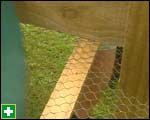 Once you get the actual frame built, attach some wire netting
underneath, to allow for proper drainage, and some slats to hold
the weight of the bed.
Once you get the actual frame built, attach some wire netting
underneath, to allow for proper drainage, and some slats to hold
the weight of the bed.
Then put some weed mat
over the netting, and place some topsoil over that. (Only cover
one half of the bin with the soil).
Worms don't actually
live in their food — the soil gives the worms a substrate in
which to live.
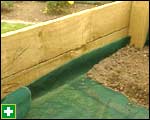 Next, Cobi has a kilo of worms to place in the farm, which is
approximately 4000 tiger and red composting worms.
Next, Cobi has a kilo of worms to place in the farm, which is
approximately 4000 tiger and red composting worms.
"For a bin this size
I would start with a kilo. They'll soon multiply themselves up from
here."
The number of worms you'll
end up with depends on the volume of food they receive, says Cobi.
"They will keep breeding
as long as they feel they have sufficient food."
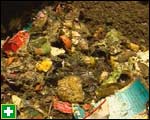 Speaking of food, that's up next. Cobi has a bucketful of banana
skins, avocado, a bit of citrus, cardboard, paper — even bills!
Speaking of food, that's up next. Cobi has a bucketful of banana
skins, avocado, a bit of citrus, cardboard, paper — even bills!
"Yes, our bills," laughs
Cobi. "We just tear them up into pieces."
Water is added to the
bucket to give everything a good soak. After a good stir, it's ready
to go into the bin. Cobi spreads it across the bed of soil, then
covers that with a piece of carpet.
Newspaper can be used
instead, but Cobi prefers the fibrous stuff.
"I always use underfelt
or carpet. Eventually they'll eat both of those."
When it next comes to
adding food, place a little bit more soil to the side of the existing
soil. Place some food on top of the new soil and a little more (a
smaller amount) to the existing soil. By doing this, you will be
slowly building the bed out (and up) until the entire bin is covered.
When you want to harvest
the vermicast, start putting food only on one half of the bin. After
a couple of weeks, all of the worms will have migrated to the side
where the food is. You can then remove the 'bare' vermicast, then
start all over again.

Reproduced
with permission from NZOOM Home and Garden content,
from the previous
website of 
The views expressed here are not necessarily those of the RNZIH
 |
|
HOME
AND GARDEN |
|
|
More
Garden Articles
|